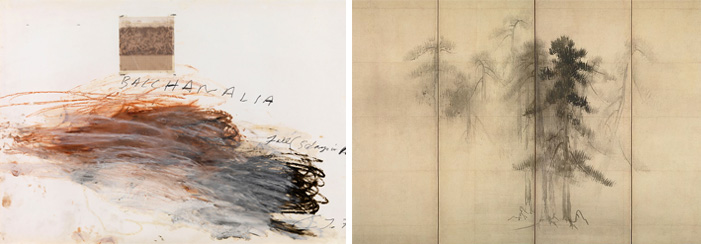My work over the past twenty years has been devoted to those landscapes that are associated with the untamed and wild landscapes that can be found in the Moors, Fens, Fells and Estuaries of Britain. I have carried those impressions of the sublime in the landscape that were left on me as a child growing up in the Fens of East Anglia, impressions that are still relevant to my work today. Recently it has been the vast immersive spaces of moorland and river estuary that have consumed my imagination and which I wish to evoke through charcoal, pencil and oil.
My influences are many and varied and include the calligraphic paintings of Cy Twombly, the tonal ink paintings of Hosagawa Tohaku and the landscapes of Constable, Claude, Cottman and Turner.

Cy Twombly:-Bacchanalia-Fall (1977) Hasegawa Tohaku: Pine trees (1593)
I have exhibited work around the country, most notably on a number of occasions at the RWA, Bristol, as well as being currently represented by Badcocks Gallery, Cornwall, who have exhibited and sold my work in London. I have also been successful as a published poet being shortlisted for the Brit Writers’ Award 2012 and winning Fleeting Magazines International Best Short Writing 2010. Writing has been put on the shelf for the time being as I wish to devote myself to landscape painting as it is for me, and probably always will be, unfinished business.
“…it is not a record of landscape, but a sensation of landscape that’s internalised within an individuals’ imagination and so completed..” (Howard Hodgkin)
“Eternity…where life is boundless in its duration and love in its sympathy, a joy in its fullness. It was a sea stretching into infinity….” (Emily Bronte from “notes on the moor”)
“Mark Stopforth’s work captured me from the first. The delicate relationship between expression, fluidity and order is one that occupies me in the searches of my own work, and in encounters with art that moves me. Mark is one of those rare artists able to balance these qualities with quiet precision, calibrating his affect exactly to the point at which its reach should cease, leaving a clear space in the ether where we can take up and build with the strands that he has placed so carefully. Only in this way can landscapes draw themselves in mind, and draw us to look outwards again, anew. This is art that leads us away from its own self-effacing fluency to a world that floats above it all, always forming before our eyes, imprinted long after the fact.” (Jim Aitchison)